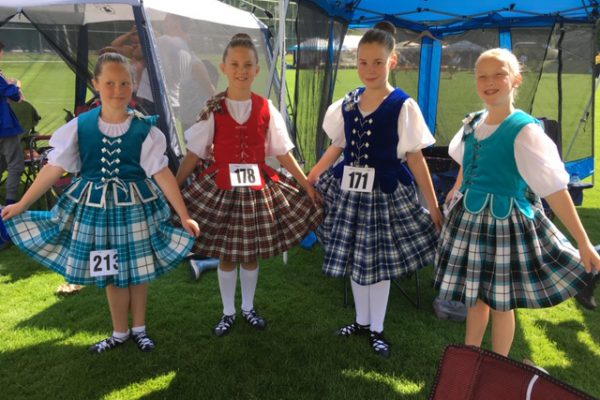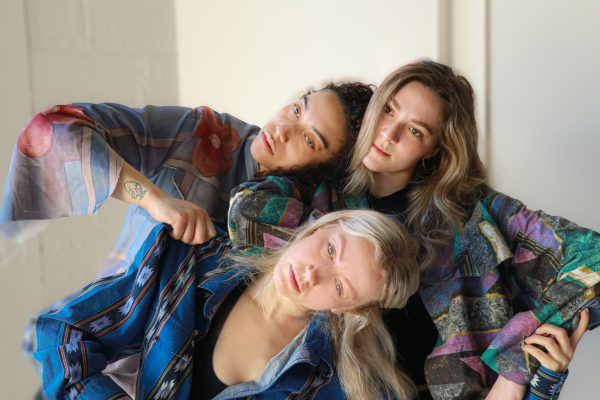Is Alberta a place where artists can produce risky work? Can art in the Prairies go beyond cowboy culture?
“Alberta audiences are not a jaded audience because they didn’t have opinions about dance, and that’s a blank page for an artistic director,” said Jean Grand–Maître, former artistic director of Alberta Ballet, about Alberta Ballet’s portrait ballet series during an interview for The Dance Current. “It’s carte blanche to start, to see what sticks, what really reverberates with [audiences], and to develop a repertoire that challenges them the right way, that doesn’t alienate them.”
This comment sparked the curiosity of interviewer Jenna Shummoogum, who decided to bring this quote to other producers, launching larger conversations about the province’s audiences. Shummoogum spoke individually with Nicole Mion, artistic director of Springboard Performance, Les Sereda, artistic director of the Ukrainian Shumka Dancers and Brian Webb of Brian Webb Dance Company. The following article has been edited together from these conversations.
***
Jenna Shummoogum: I have this joke that portrait ballets are a gateway, [like a gateway drug]. Do you feel the same way?
Jean Grand-Maître: A portal, right? It’s a portal to new audiences. When I worked in Europe, the audiences [were] very jaded and they’re very opinionated about dance and how it should be. In Munich, it should look like this; in Stuttgart, it should be like that. They’ve been looking at dance and they all know dance. So they’re a difficult audience to start off with. When I arrived in Alberta, they didn’t know what [ballet] was. They were excited by the athleticism because there’s a lot of Olympians that train here. They love athleticism and beauty, like figure skating, and I knew that there was a way to connect with them.
JS: Do you agree with what Jean said about Alberta being a blank slate?
Les Sereda: Brian Webb and I talk about this all the time. Brian’s programming for the Brian Webb Dance Company is not always about what he thinks an audience is going to love, but he challenges an audience to continue to evolve. It’s maybe not the best way financially to run it, but he pushes an audience to continue to think beyond the norms. And where else can you do that? I agree with Jean; our audiences continue to be open and grow with us as we continue to find those journeys. We’ve collaborated with Alberta Ballet, we collaborate [with] Brian Webb, I’ve collaborated with Wen Wei Wang, with Ballet Edmonton. How beautiful is that? It’s just cool that we can build relationships like that, that allow us all to be creative and support each other. That’s a pretty unique place to work.
Brian Webb: I agree with Jean, but I’m going to describe it in a different way. I feel in Alberta’s psyche is the love of mavericks. And I think Albertans have a respect for the maverick spirit. The only problem is that Jason Kenney is a maverick. He’s a maverick if ever there was one. I’m a maverick. I’ve always been a maverick. I march to my own drum. And I was never discouraged here. Never. I mean, I did some wild dances. We don’t all have to be the same here. We can also develop our art form. If you’re a strong person, in a very individual way, you don’t have to buy in to what is hip in the community. I think in terms of the development of art, that’s important.
I feel in Alberta’s psyche is the love of mavericks… If you’re a strong person, in a very individual way, you don’t have to buy in to what is hip in the community. I think in terms of the development of art, that’s important.
Brian Webb
Nicole Mion: I think you can create from a clean slate. I feel as an arts person in Alberta, you are still within the gravitational pull of oil and the landscape. And that creates possibilities, and it creates some challenges. There was always the possibility of thinking in new ways. If you have a good idea, people are willing to say yes, as opposed to ‘What’s your pedigree? What’s your kind [of] proof?’ We do really celebrate the maverick spirit here. Just like the Indigenous Peoples say, you’re so shaped by the land and the gravitational pull of the place. I kind of love it now. It was a long process of love, hate and reaction against something and building something.
JS: What do you like about Alberta audiences? What’s unique about creating in this landscape?
JGM: Alberta audiences have libido, they have mojo, there’s an energy before the show starts, the dancers feel it, always backstage, there’s a buzzing theatre. It’s been a great love affair. You know, it is a love affair between an organization and an audience. You create an affair with your audience, and you grow from this relationship, like a love affair. For me, the most important aspect of Alberta audiences was this willingness and this energy in the room, both in Calgary and in Edmonton, but in different ways, very different ways. But they both have that yearning for new ideas.
When I moved here in 2002, things were starting to change. You could see Ethiopian restaurants opening up and then art galleries and cafés, and then you started seeing less white people downtown. You started to really see the change in Alberta. And to be part of that change was exciting. [The] majority of Albertans wanted influence to come in from outside. They wanted people to move here from Europe and all over. I never once had the sense that I was this fresh Canadian who didn’t belong here.
NM: I don’t think this is about Alberta. I feel art is part of an international community. And we all need to be part [of it]. We need to all play a part in a global community. That art helps us experience different perspectives. And because of those two things, I have absolutely no problem with bringing art from elsewhere to Alberta. And I equally think that art from Alberta should be seen elsewhere, for the same reason, and I would say that the balance hasn’t been perfect. With consistency and a deepened appreciation, you can prepare [a] community to cultivate a sense of what something is, right? I hope I’ve played a good part in cultivating a sensibility of what we can expect here. And we can expect a lot. And we can take in a lot. And we are sophisticated. And we are so educated here.
I don’t think this is about Alberta. I feel art is part of an international community… art helps us experience different perspectives… I have absolutely no problem with bringing art from elsewhere to Alberta. And I equally think that art from Alberta should be seen elsewhere
Nicole Mion
People think that not much is happening in Alberta, and I’ve been trying to broker some of the creative exchanges and residency work, or bilateral exchange, so that we are encouraging artists to leave the province as much as we’re encouraging artists to come to the province. We are most healthy when both are happening. We have a responsibility to be part of a global community of ideas, and we should play a rigorous part in that. I think it’s equal in that we dig deep into what is here and what is elsewhere. And both can inform being here.
Cultivating a culture of attending the arts like the community [that supports Shumka in Edmonton] is what is lacking. It has been lacking. There are certainly folks who are real passionate supporters and practitioners, but as an ecosystem, that’s where our gap is.
LS: Ukrainian dance is its own little world of the dance culture here in Alberta. We have pushed against what would be the norm of what Ukrainian dance is in Alberta. And we do get some pushback, because we push those boundaries. We’ve done this for so long that our audiences know that we’re going to continue to push up what the boundaries of Ukrainian dance is.
JS: What’s it like to create in Edmonton?
LS: Edmonton is a wild place from an arts perspective. People support the arts incredibly well here and support diverse arts in a city. I think there is something that feels right about Edmonton and the arts community and the support that it receives. It’s a very open and giving community to be part of, and that’s something special that I don’t think every city has. And I think Edmonton might just be small enough that there’s a sense of collaboration within the community that bigger cities don’t have.
JS: People might not know this, but Edmonton has the biggest fringe festival in North America. Can you speak to Albertan artistic success?
BW: There are other things too. There is a long, long history of artmaking [in this province]. Did you know that the Banff Centre was started by the University of Alberta in Edmonton? The first big art program in Canada, the first and biggest bachelor of fine arts drama program in the country was at the University of Alberta.
Edmonton is a wild place from an arts perspective… It’s a very open and giving community to be part of, and that’s something special that I don’t think every city has. And I think Edmonton might just be small enough that there’s a sense of collaboration within the community that bigger cities don’t have.
Les Sereda
JS: You’ve chosen Alberta, you’ve been in this province creating. Why do you stay in Alberta?
NM: I went to school in Calgary, and then I also went to school in Montreal. I swore I would just get the hell out of dodge. But I would also get these gigs here. And that kind of pulled me back. I had that opportunity to really hone my skill as a creator and as a curator. My first job out of university was at the Banff Centre. Those things kept me coming back and helped me come to terms with my love-hate relationship with Alberta. Through so many years, the Banff Centre has inspired me as to what’s possible, in a place where people think nothing’s happening. The fact is there’s nothing like the Banff Centre anywhere in Canada. That’s in Alberta. And that’s really a powerful thing. When I see folks with their careers in Montreal, there’s enough infrastructure there that as a young artist, your place is really to push against the structure, to find your structure. In Alberta, there was just no structure. It was a place to build structure, and that’s a great possibility. It’s a magic time when you can do that. So your original question is why you stay in Alberta? Certainly a radical proposition, isn’t it? Or maybe even just thinking about the politics. What does it mean to be a creative artist in the politics of Alberta? [It] certainly, I think, appeals to a radical spirit.
JS: Brian Webb spoke about Alberta celebrating the maverick spirit. Do you agree?
NM: It sounds cliché, but really, it’s there. Maybe we could think about it like this: There is the possibility of a huge open sky; you can really see far into the distance on the Prairie landscape. That is the way one can think about art. The same vast possibility. And at the same time, it’s a cold winter. It’s not a tropical climate where you can just figure it out as you go; you must be ready for the winter. You must create a vision and some practicality and [a] way of thinking to keep creating. There is a possibility of what you can realize here with a little bit more space and time, like the Prairie landscape that I think can be a good psychological creative place, if you’re able to generate the ideas on your own.
I feel like my practice has been shaped by this place.
This conversation has been edited for clarity.
Dance Media Group strengthens the dance sector through dialogue. Can you help us sustain national, accessible dance coverage? Your contribution supports writers, illustrators, photographers and dancers as they tell their own stories. Dance Media Group is a charitable non-profit organization publishing The Dance Current in print and online.

Tagged:






